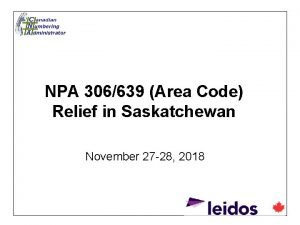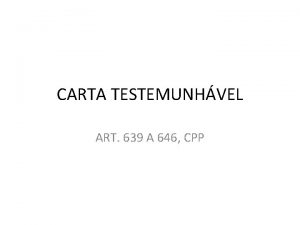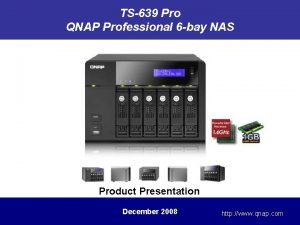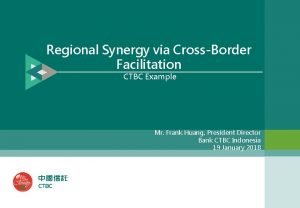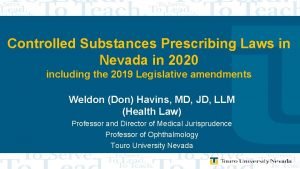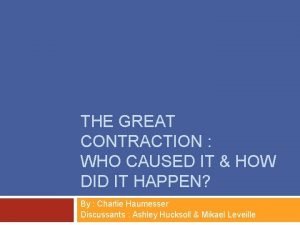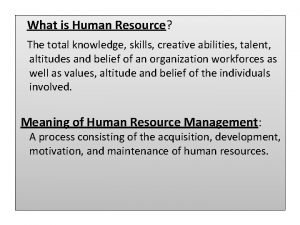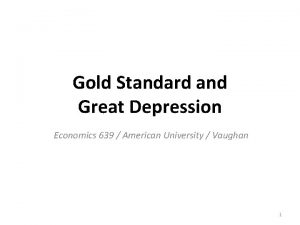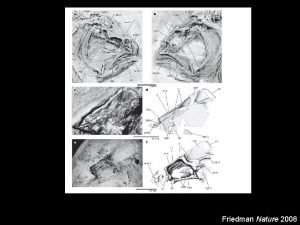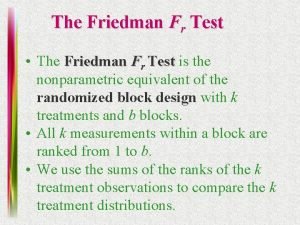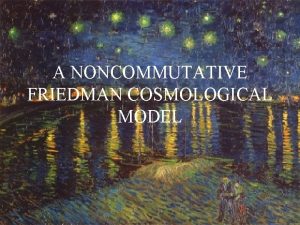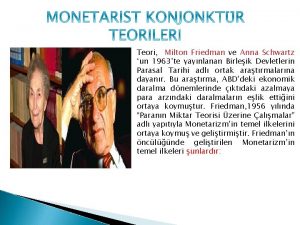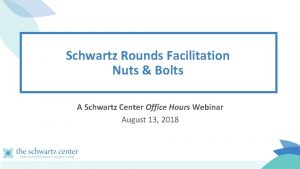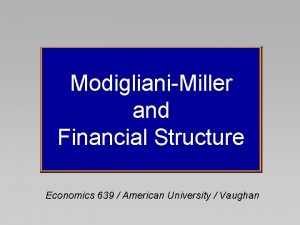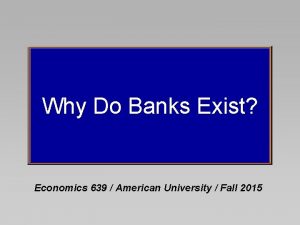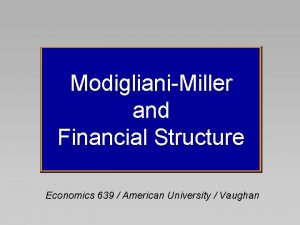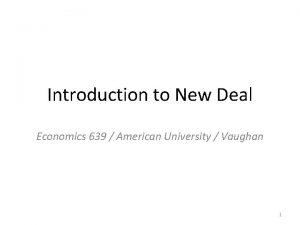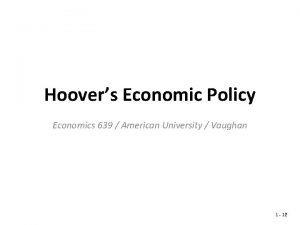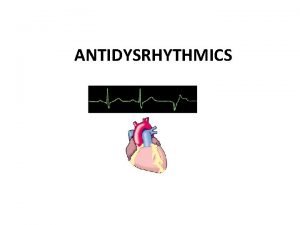Friedman Schwartz The Great Contraction Economics 639 American
















- Slides: 16

Friedman & Schwartz “The Great Contraction” Economics 639 / American University / Vaughan 1 - 16

Overview “The Great Contraction” • Chapter 7 of Friedman and Schwartz’s magisterial A Monetary History of the United States, 1867 -1960. • One of two most important macroeconomics books of 20 th century (along with Keynes’ General Theory). – Dispelled notion money is macroeconomic “sideshow. ” – Documented prominent role of money in Great Depression. • Seminal contributions include: – Consistent money-supply series for 93 years of U. S. history. – Empirical link between (i) money & output (short run) and (ii) money & prices (long run). – “Natural experiments” show money often causal. 2 - 16

Background Bank Balance Sheet • Checkable deposits are demandable at par (“first come, first served”). • U. S. banks must hold 10% of checkable deposits as vault cash or deposits at Fed (“reserves”). – Reserves held above required levels are called “excess reserves. ” • Banks hold securities as “secondary” reserves to provide liquidity. • Capital is owner’s stake in bank. – Losses on loans/securities subtracted from capital – Risk appetite varies indirectly with capital. 3 - 16

Background Multiple Deposit Creation • Banks earn profit from loans (return exceeds that on reserves and securities). • Assume member of public deposits $1 of currency. Bank must hold 10% of deposit as reserves, so 90 cents of new dollar of deposits will be lent. • Mechanically, bank makes loan by adding amount of loan to “loans” on asset side of balance sheet and “checkable deposits” on liability side (i. e. , funds placed in loan customer’s checking account). • When loan customer spends proceeds (90 cents), that amount will end up deposited in another bank. – RESULT: Total deposits created by banking system “creates” are multiple of original $1 in currency deposited. 4 - 16

Background How Fed Manipulates Money Supply • Money: Financial asset used for transactions (narrowly – currency and checkable deposits). • Open-Market Operations: Fed purchase or sale of securities, transaction settled with bank reserves. – Fed purchases of securities increase bank reserves, leads to multiple deposit creation (Ms↑). – Fed sales of securities decreases bank reserves, leads to multiple deposit destruction (Ms↓). 5 - 16

Background Drivers of Money Supply = Money Multiplier x Monetary Base • Monetary Base (also “high-powered money”) = currency-in-circulation + reserves held by banks ‒ Base under central-bank control (in discretionary policy regime) • Money Multiplier: Maximum supply of “money” that can be created with monetary base – Depends on public preference for currency (C) over deposits (D) and bank preference for holding reserves (R) over lending. Ø Greater public preference for currency → Smaller money multiplier Ø Greater bank preference for reserves → Smaller money multiplier 6 - 16

Money and Output in Great Depression What caused money stock to collapse? 7 - 16

Monetary Contraction in 1930 s Were Panics Driving? NOTE • Stock-market crash did not “cause” large decline in money stock. • Money-stock decline became more pronounced with each panic. 8 - 16

Panics and Money Supply, 1929 -33 Base or Multiplier? • Logically, moneystock decline must come from fall in (i) money multiplier, (ii) monetary base or (iii) both. August 1929 – March 1933 Monetary Base↑ 25. 7% • Monetary base did not drive 1929 -1933 decline in money stock. 9 - 16

Panics and Money Supply, 1929 -33 Base or Multiplier? Great Contraction August Culprit: 1929 Money – March Multiplier! 1933 M 2 Money 1929 Multiplier ↓ 1933 48. 7% August – March Money Multiplier↓ 44. 9% But how did panics cause money-multiplier collapse? 10 - 16

Bank Panics and Money Multiplier 1929 -1933 “Failures” • Fed created to supply banks with emergency liquidity to stop panics. ‒ No longer private institutions to contain panics. • In four 1930 -33 panics, public converted deposits (D) to currency (C) to avoid losses from bank failures (Result: D/C↓) and banks horded reserves (R) to prevent insolvency (Result: D/R↓). 11 - 16

Panics and Multiplier Components NOTE: • • Deposit-Currency Ratio (D/C) and Deposit-Reserves Ratio (D/R) did not start declining significantly until first banking panic began (November 1930). With each successive panic, rate of decline increased. 12 - 16

Panics and Money Supply, 1929 -33 Summing Up Note: • Money multiplier drove overall 1929 -33 money stock decline. • Bulk of 1929 -33 money-stock decline took place after start of first panic. • Panics caused both deposit-currency ratio (D/C) and deposit-reserve ratio (D/R) to tumble. 13 - 16

What Should Fed Have Done? According to F&S Congress pressured System to buy $1 billion in securities from April to June 1932 - temporarily halting money-stock decline but not turning economy around (too little, too late). Doing same thing earlier might have worked wonders: • First Ten Months of 1930: Purchases would have made banking crisis less likely by (i) reducing severity of contraction and (ii) increasing bank reserves (i. e. , increasing ability to meet deposit outflow). • First Eight Months of 1931: Purchases would have increased base enough to offset decline in D/R and D/C, leaving money supply unchanged (rather than 5% decline). • Four Months Following Britain’s Departure from Gold in 1931: Purchases would have increased base enough to offset most of drop in D/R and D/C, thereby cutting money-supply decline in half. – Had drop in D/C been moderate, money supply would not have fallen (rather than decline 12%). 14 - 16

Why Didn’t Fed Intervene Aggressively to Stop Panics / Boost Money Supply? • F&S: System responded belatedly/weakly to failures because of poor understanding of connection among bank failures, bank runs, deposit contraction, and money supply. • Other factors cited by F&S: – – – Fed cared little about non-member banks (bulk of failures). Most failures small banks; big-city bankers dominated System. Few large banks that did fail badly managed. Intellectual vacuum in Fed after Benjamin Strong’s death (1928) Fed focused on maintaining dollar’s value in gold. • Other factors not cited by F&S: – No panics in New York City – Low nominal interest rates wrongly seen as “easy money. ” Ø Problem of identifying stance of monetary policy persists! 15 - 16

Concluding Thoughts Subsequent research has: • De-emphasized 1930 failure of Bank of United States in triggering panic. ‒ Catalyst: Failure of Caldwell & Company (Nashville (caused by bad real-estate loans). • Shown 1930 -32 runs were regional, not national. • Indicated runs mostly “rational, ” not indiscriminate panic. • Traced February 1933 runs to bad policy (state bank holidays). 16 - 16
 Refractory period of smooth muscle
Refractory period of smooth muscle 639 area code
639 area code Subsisir
Subsisir I-fss-639
I-fss-639 Ts-639 pro
Ts-639 pro Ctbc 639
Ctbc 639 E prescribing controlled substances nevada
E prescribing controlled substances nevada The great contraction
The great contraction Maastricht university economics and business economics
Maastricht university economics and business economics Mathematical economics vs non mathematical economics
Mathematical economics vs non mathematical economics Jaggi and lau model of hra
Jaggi and lau model of hra Tawassol prof
Tawassol prof Exemple de valeur personnelle
Exemple de valeur personnelle Retenedor de arco continuo
Retenedor de arco continuo Schwartz child wormhole
Schwartz child wormhole Dr betsy schwartz
Dr betsy schwartz Tom schwartz tinman
Tom schwartz tinman

